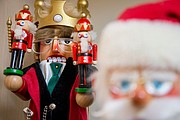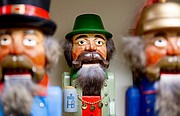A world of nutcrackers
If German nutcracker folklore is true, Claudia Jean Davis’ Hayden Lake home is well-defended against evil spirits.
C.J. Davis owns around 2,800 nutcrackers, one of the largest collections in the world. The only larger assortment is at the Nutcracker Museum in Leavenworth, Wash., where Davis sits on the board.
Davis’ whimsical and colorful personal collection includes hundreds of the wooden soldier nutcrackers first depicted in “The Nutcracker and the Mouse King,” the 1816 story that inspired the well-known Christmas ballet, “The Nutcracker Suite.”
Those toothy, dour-looking, bearded and mustached protectors are just one type of nutcracker found in Davis’ diverse collection, but an integral part of the German nutcracker tradition. She said every collection starts with four characters crafted by all German nutcracker-makers: the king, the guard, the chimney sweep and the musician.
“The king protects your collection. The guard guards the king. The chimney sweep is a sign of good luck in European homes, and the musician draws attention to your collection,” Davis said. “After that, all the rest — the bakers, the winemakers and the dentists — they’re here to appease your king.”
Her father, Hal Davis, started the collection now displayed on shelves in a special room in Davis’ home. He passed away in 1989, leaving her roughly 2,000 pieces, and asked her to keep the collection going.
“Then it grew and grew, faster than I could dust,” she said.
Davis was six when her father started the collection in 1954. He purchased his first nutcracker while on a road trip, somewhere between Iowa and Wisconsin.
Chiseled out of boxwood in the shape of the head of a gnome, the nuts are placed in the back of the head for cracking. Davis said it originated in the Tyrolean region of Europe.
“He just fell in love with it and bought it,” she said.
The collection includes several life-sized nutcrackers including a happy, 6-foot tall German. With his big smile, hat and lederhosen, he looks ready for some folk dancing.
“Newtcracker” is another larger piece in Davis’ collection. Designed by a clockmaker she knows, “Newtcracker” holds a tray for nuts, and is dressed in a pinstripe suit with a red, white and blue tie.
There are shelves and shelves filled with nutcrackers by the late Christian Steinbach, and 90 percent of them were signed by the man known as the “King of Nutcrackers.” Steinbach’s family has operated a wood-carving business in Germany for nearly 200 years.
Davis developed a friendship with Steinbach, who died in 2007. She has personal letters from him and was pictured in a book by the artist.
While Davis’ collection includes an extensive number of German-made pieces, there are many from Italy, Austria, Russia, the U.S. and other corners of the world. There is a kangaroo nutcracker from Australia, and a set of kachina-style American Indian pieces.
A Rube Goldberg-style nutcracker, designed by Davis’ father, stands out. A coin rolls down a chute, and bounces causing a candle to be ignited. The candle flame burns through a straw, eventually causing a large piece of wood hanging on a rope to come crashing down to crack a nut placed below.
In addition to the many wood-carved nutcrackers Davis has, there are lots of uniquely shaped implements made of different materials — metals, china and antique ivory.
A section of the collection is filled with handheld nutcrackers, including a large set adorned with antelope heads. There are crackers shaped like frogs, elephants, squirrels and more. Some nutcrackers represent moments in history, pop culture or U.S. presidents. Others double as music boxes or banks. The characters from many classic stories — “A Christmas Carol,” “The Wizard of Oz” and more — stand ready to crack nuts. However, Davis never uses her pieces for cracking.
“Those are some of the oldest known nutcrackers,” she said, pointing to some “nutting stones.” “Some of those go back 8,000 years. They are over in the museum in Leavenworth.” She couldn’t estimate the value of the collection, but many of the traditional German nutcrackers sell for several hundred to several thousand dollars each.
Davis often packs up 20-35 nutcrackers and takes them on the road, visiting schools and senior citizens’ groups.
“I never left a presentation where they weren’t enthralled with them,” Davis said.
That’s one of the things Davis enjoys most about her collectibles.
“They attract neat people. Everyone loves nutcrackers. Anyone who comes to see them leaves with a smile,” she said.
Another section of Davis’ collection includes a set of American-made nutcrackers. Unlike those crafted by German artists, the American characters are depicted with their mouths closed, without the large teeth seen on the German designs.
Davis explained it stems from a difference in folk beliefs.
“Like a trusty dog, they come out at midnight and say, ‘Hail to thee,’ and it’s to ward off evil spirits. That’s why the German nutcrackers show the teeth. American artists don’t believe that folklore,” Davis said, smiling. “So, it’s very, very loud here at midnight — very loud.”
She plans to give the collection to the museum in Leavenworth, but not just yet.
“I’ll donate them when I’m done enjoying them,” she said.





